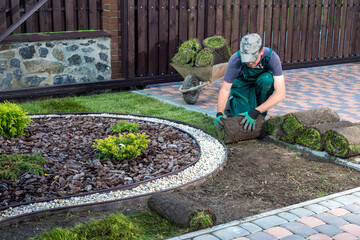Trees are among the most valuable natural assets in any landscape. They provide shade, enhance curb appeal, purify the air, and contribute to overall well-being. However, like any living organism, trees require consistent attention to thrive. Proper tree care ensures that they remain healthy, safe, and beautiful for years to come. Whether in residential yards, commercial spaces, or public areas, caring for trees is an investment that yields long-lasting benefits.

The Importance of Tree Care
Many people assume that trees can survive without help, but in urban and suburban environments, they face unique challenges. Poor soil quality, limited space, pollution, pests, and improper pruning can weaken even the strongest species. By implementing effective tree care practices, property owners can:
- Promote Longevity: Healthy trees can live for decades or even centuries with the right care.
- Enhance Safety: Regular maintenance prevents falling branches and reduces the risk of damage during storms.
- Boost Aesthetics: Well-maintained trees improve the appearance of homes, businesses, and neighborhoods.
- Increase Property Value: Landscapes with mature, healthy trees are often more attractive to buyers.
- Support the Environment: Trees improve air quality, conserve energy by providing shade, and create habitats for wildlife.
Essential Elements of Tree Care
Tree care goes beyond watering and occasional trimming. It involves a combination of practices that address health, growth, and safety. Some of the most essential elements include:
- Pruning and Trimming
- Regular pruning removes dead, diseased, or overgrown branches. It improves airflow, allows sunlight to reach the inner canopy, and encourages healthy growth. Trimming also helps shape the tree for aesthetic appeal and ensures clearance from structures, power lines, and walkways.
- Watering
- Trees need adequate water, especially when young or newly planted. Deep, infrequent watering encourages roots to grow deeper into the soil, making the tree more resilient during dry periods. Mature trees may require less frequent watering but still benefit from proper hydration during droughts.
- Fertilization
- Urban soil often lacks the nutrients trees need. Fertilizers replenish essential minerals, boost growth, and strengthen resistance to pests and diseases. Proper fertilization should be tailored to the tree species and soil conditions.
- Mulching
- Applying mulch around the base of trees helps retain moisture, regulate soil temperature, and suppress weeds. Mulching also improves soil structure as it breaks down, providing long-term nourishment.
- Pest and Disease Management
- Insects and diseases can quickly damage or kill trees if left untreated. Regular inspections help identify issues early. Integrated pest management and safe treatment methods can protect trees without harming the surrounding environment.
- Tree Health Assessments
- Routine evaluations by tree care specialists ensure that potential risks are addressed before they become serious. Inspections can detect root problems, structural weaknesses, or signs of decay.
Tree Care for Different Seasons
Each season brings unique challenges for trees, making year-round care essential.
- Spring: Inspect for winter damage, prune dead branches, and fertilize to encourage new growth.
- Summer: Maintain watering schedules and monitor for pests and diseases.
- Fall: Remove fallen leaves, apply mulch, and prepare trees for colder temperatures.
- Winter: Protect young trees from frost, inspect for structural integrity, and plan pruning for dormant periods.
Tree Planting and Early Care
Proper tree care begins at planting. Choosing the right species for the soil, climate, and available space is essential for long-term success. Young trees require special attention, including consistent watering, support staking, and protection from lawn equipment. Establishing healthy roots early ensures a stronger, more resilient tree in the future.
Signs a Tree Needs Attention
Recognizing the warning signs of tree distress is crucial for early intervention. Some indicators include:
- Wilting leaves or premature leaf drop.
- Dead or broken branches.
- Cracks in the trunk or large limbs.
- Visible pests or fungal growth.
- Leaning or unstable root systems.
Addressing these issues promptly prevents further damage and may save the tree.
The Role of Professional Tree Care Services
While property owners can handle basic care such as watering and mulching, many aspects of tree care require professional expertise. Specialists use advanced equipment and knowledge to safely prune large trees, diagnose diseases, and manage risks. They also provide emergency services after storms to remove hazardous limbs or fallen trees.
Hiring professionals ensures that trees are cared for correctly and safely, reducing the risk of injury or property damage. Their guidance also helps property owners develop long-term maintenance plans that support the overall health of their landscapes.
Environmental Benefits of Healthy Trees
Beyond their beauty, trees provide essential ecological benefits. They absorb carbon dioxide, produce oxygen, and filter pollutants from the air. Their shade reduces energy consumption by cooling homes and businesses, while their root systems prevent soil erosion and support water conservation. By investing in tree care, individuals also contribute to a healthier planet.
Tree care is a vital part of maintaining safe, healthy, and attractive landscapes. Through regular pruning, watering, fertilization, and disease management, trees can thrive for generations. Seasonal care and early intervention ensure that potential issues are addressed before they become major problems.
Whether planting a young sapling or maintaining a mature tree, consistent attention is key to preserving strength and beauty. With professional support and proper care practices, property owners can enjoy the many benefits that trees provide—shade, safety, value, and natural beauty.
Caring for trees is more than just maintenance; it is an investment in the future. By nurturing them today, we ensure greener, healthier, and more vibrant landscapes for tomorrow.